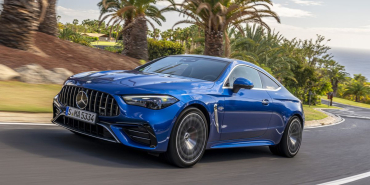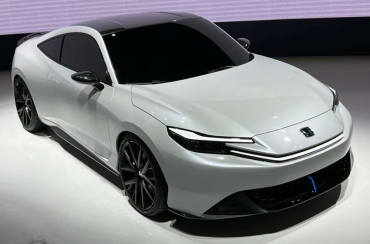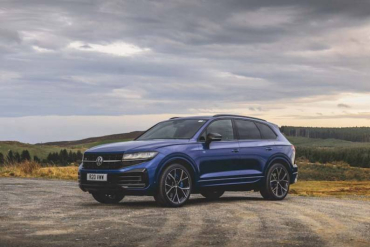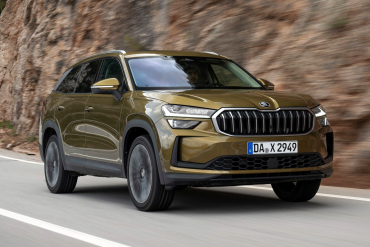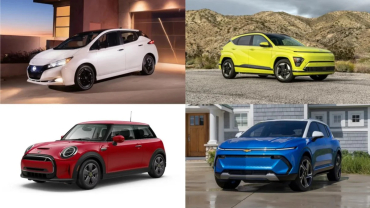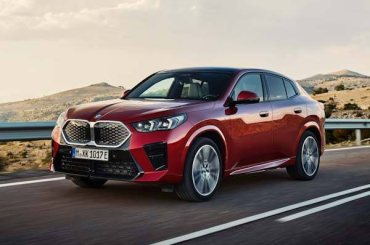
Worldcarblog.com
2024 Mercedes-AMG CLE53: The Coupe, Made Swole
"We're going to pump—[clap!]—you up!" One imagines Hans, Franz, and all their pals at AMG reacting thusly to the new Mercedes-Benz CLE coupe, which debuted last summer in four-cylinder CLE300 and six-cylinder CLE450 form. After a muscle-building regimen at AMG HQ in Affalterbach, the result is the Mercedes-AMG CLE53.
The vertical-slat grille may be the first-noticed telltale that this is the AMG version, but the more transformative elements are the swollen front and rear fenders that accommodate similarly wider tracks, by 2.3 inches in front and 3.0 in back, compared to the regular CLE coupe. Additionally, the AMG-specific front fenders allowed the CLE53's front wheels to move 0.4 inch forward, giving the car a fractionally longer wheelbase. The lower front air intake also grows larger, the reshaped hood incorporates a functional vent, sill extensions protrude from the lower body, there are quad exhaust outlets, and the decklid sprouts a small ducktail spoiler. The optional AMG Performance Studio package adds a rear diffuser, a larger rear spoiler, and tweaks to the front fascia. The sum total of the changes gives this car some visual menace, and the available matte paint finish really helps that vibe.
What Motivates the CLE53
The CLE53 doesn't follow the lead of the Mercedes-AMG C63 sedan, which employs a highly complex turbocharged four-cylinder plug-in-hybrid powertrain. Instead, it sticks with a turbocharged and supercharged 3.0-liter inline-six. As in the CLE450, the turbo six is aided by a 48-volt hybrid system, but the AMG version kicks things up a notch. In the CLE53, it's energized with 443 horsepower and 413 pound-feet of torque—with an overboost function adding another 30 pound-feet for up to 10 seconds. Those are hearty increases over the Benz variant (375 horses, 369 pound-feet) and also represent a bump of 14 horses over the previous "53" models. The extra output comes courtesy of a new electrically driven turbocharger that increases boost pressure and provides the overboost function. Additional changes include new piston rings and revamped inlet and outlet channels.
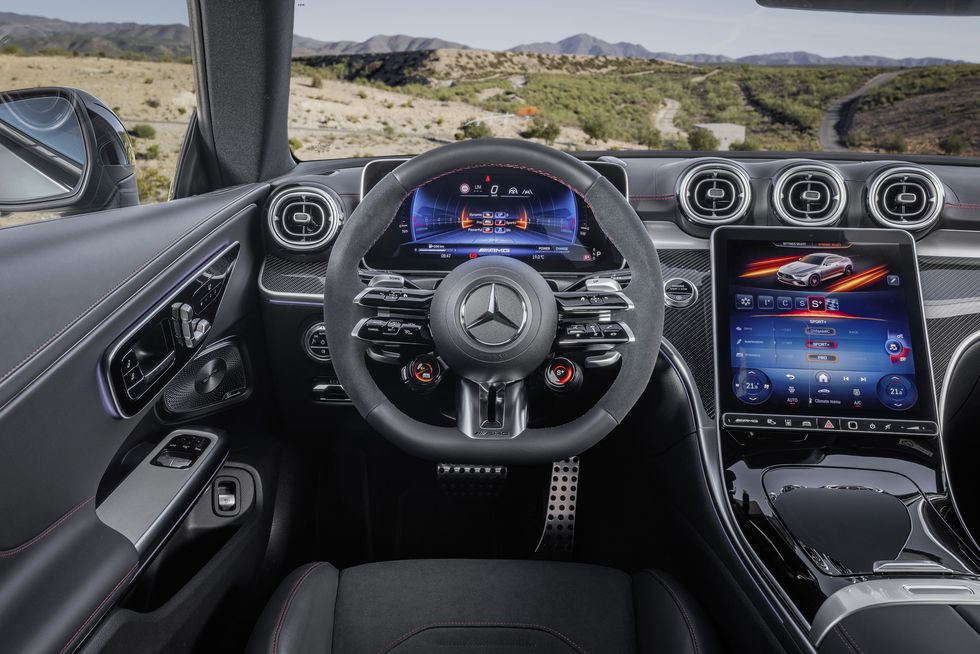
While the rival BMW M4 offers a manual transmission, AMG has no interest in manuals, and there isn't one here. Shifting duties are handled by an AMG-modified nine-speed automatic that, unusually for AMG, retains a torque converter. Even without a clutch pack, however, it still incorporates a Race Start function, which is accessible in Sport mode and above, simply by holding the brake and mashing the gas. All-wheel drive is standard, as it is in all CLE models, and AMG's rear-biased system can decouple the front axle and send 100 percent of the grunt rearward. Spec the AMG Dynamic Plus package, and you get a Race drive mode in addition to Comfort, Sport, Sport+, Individual, and Slippery. Within Race, a Drift function can be unlocked, though it's a multistep procedure. The package also includes adaptive engine mounts and red brake calipers. All CLE53s have the same brake hardware, however, with 14.6-inch vented front discs squeezed by four-piston calipers and 14.2-inch vented rear discs. An AMG Driver's package available in other markets raises the speed limiter from 155 mph to 168 mph, but it won't be offered in the U.S.
Driving the CLE53
The boosted six fires up without the throat-clearing of AMG's V-8s, and even with the active exhaust switched into its more vocal program, there's only the faintest burble when lifting off the throttle. Still, the engine sounds great as it climbs the tach, and we don't miss the theatricality—although some might. The powertrain is plenty strong, with AMG quoting a 4.2-second zero-to-60-mph time and 4.0 seconds with Race Start. That strikes us as conservative; we expect a number in the high threes.
We drive a nearly endless series of curves climbing up and down the mountains in Tenerife, Spain, with zero runoff and only occasional guardrails, and the CLE53's helm provides a welcome measure of feedback, more notably in Sport and Sport+. This marks a real improvement over the standard CLE coupe. We'd wish only for a greater buildup of effort when winding on more lock. Powering out of slow corners, the more rearward torque bias in the sportier drive modes also can be felt, and the standard rear-wheel steering, which turns the rear wheels opposite the fronts by up to 2.5 degrees at speeds up to 60 mph, sharpens cornering response. AMG fits the CLE53 with steel springs and adaptive dampers, which vary in stiffness based on the drive mode. Firm body control is to be expected in an AMG product, and you'll find that here. Stray from Comfort mode, however, and you'll also feel some ride harshness.
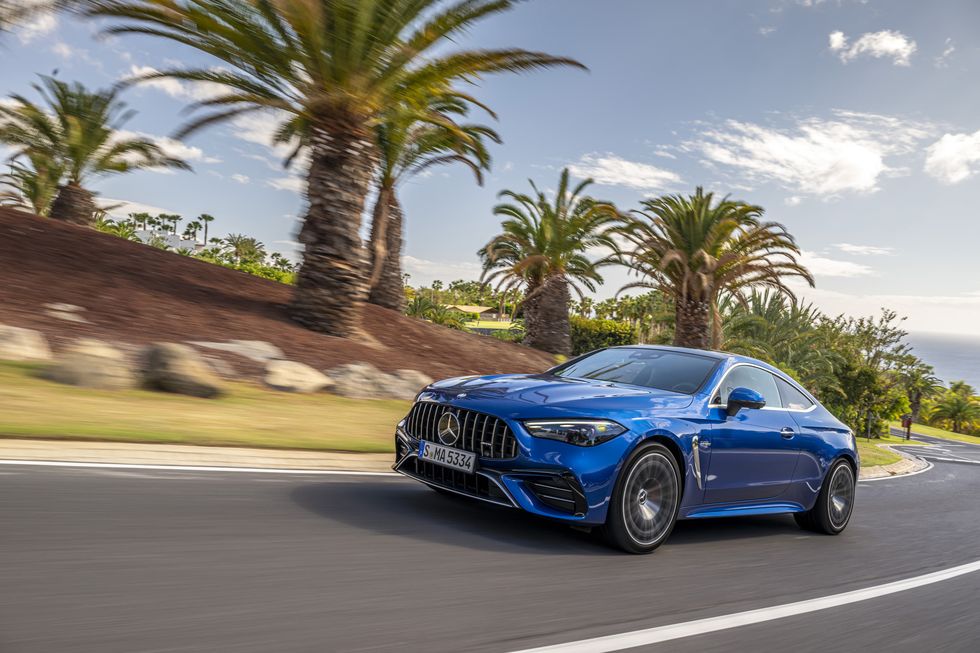
The car we drove had the optional AMG Performance Seats, which are firmly padded and narrow at the hips, but they do hold you in place—and without the sadism of the most extreme BMW M chairs. The driver looks out over an AMG-specific hood with twin raised bulges. In tight corners, you find yourself peering around the beefy A-pillars, and as you might expect, rearward visibility through the dramatically sloping back glass is not great.
The AMG-specific steering wheel includes two dials to switch among the overall drive modes or individual parameters (exhaust, suspension, etc.). The CLE53's 12.3-inch instrument screen allows the driver to keep tabs on additional performance metrics compared to the regular CLE, but the 11.9-inch center touchscreen with the third-gen MBUX system is essentially the same as in the Benz coupe and C-class sedan. This infotainment can't match the ease of use of BMW's 4-series, and the touch-sensitive buttons and sliders are not ideal during high-intensity driving.
Currently, this is the sole Mercedes-AMG two-door other than the SL and AMG GT sports cars. Looking at competing coupes, the CLE53 lines up nicely against the Audi RS5 but isn't as powerful as the BMW M4, nor is it as hardcore as the M4's CS and Competition variants. However, while this is the first time AMG laid its hands on the new coupe, it may not be the last—we anticipate a CLE63 variant will join at some point. A more steroidal AMG CLE may be in the offing, but the gym-toned CLE53 successfully brings a dose of the brand's characteristic swagger to Benz's mid-size two-door.
Specifications
2024 Mercedes-AMG CLE53
Vehicle Type: front-engine, all-wheel-drive, 4-passenger, 2-door coupe
PRICE (C/D EST)
Base: $80,000
ENGINE
supercharged, turbocharged, and intercooled DOHC 24-valve inline-6, aluminum block and head, direct fuel injection
Displacement: 183 in3, 2999 cm3
Power: 443 hp @ 6100 rpm
Torque: 443 lb-ft @ 2200 rpm
TRANSMISSION
9-speed automatic
DIMENSIONS
Wheelbase: 113.2 in
Length: 191.0 in
Width: 74.2 in
Height: 56.5 in
Passenger Volume, F/R: 55/37 ft3
Trunk Volume: 15 ft3
Curb Weight (C/D est): 4400 lb
PERFORMANCE (C/D EST)
60 mph: 3.8 sec
100 mph: 9.8 sec
1/4-Mile: 12.2 sec
Top Speed: 155 mph
EPA FUEL ECONOMY (C/D EST)
Combined/City/Highway: 23/20/28 mpg
Source: caranddriver.com
The new Honda Prelude will have a hybrid drive and over 200 "horses"
At last year's Tokyo Motor Show, Honda surprised everyone by revealing the Prelude concept. The company has already confirmed that the production version will be a hybrid-powered coupe, and Best Car Web now provides insight into new details on the car's powertrain, dimensions and price.
It was previously known that the production Prelude would have a hybrid powertrain, which chief engineer Tomoyuki Yamagami said would serve as a "prelude" to Honda's future electric vehicles.
Best Car believes it will have the same 2.0-liter four-cylinder e:HEV engine that powers the Civic Hybrid, with a total combined output of 207 hp.
The Prelude will reportedly be 4,300mm long, 1,790mm wide and 1,300mm tall, while the wheelbase will be 2,575mm.
That makes it bigger than the Mazda MX-5 Miata, unsurprisingly, and almost identical to the Toyota GR86.
Honda is reportedly positioning it as a premium model above the aforementioned Toyota.
In Japan, the new Prelude will reportedly cost between $27,300 and $29,300. By comparison, the GR86 costs $18,900-$23,400 in the same market.
It is expected to arrive in showrooms by the second half of 2025.
Volkswagen Touareg R review
The most powerful car in the entire Volkswagen line-up is this model, the Touareg R. This dynamic 462PS luxury large SUV was the first of the brand's sporting R models to feature plug-in drive. And it was the first all-wheel drive model in VW's PHEV range. Here's the improved version.
Background
The Touareg R is a step beyond any version of Volkswagen's largest SUV that we're previously seen. It's also a very different car from any that the Wolfsburg marque's 'R' sub-brand has attempted to develop before, taking its place above the T-Roc R and Tiguan R performance SUV models that the brand's R division launched before it.
Before we first saw this Touareg R in 2020, some had expected this fastest Touareg to use the fiery 600PS mild hybrid petrol V8 from the Audi RS Q8. Or perhaps the 435PS V8 BiTDI diesel engine from the Audi SQ7. The 462PS petrol V6 it arrived with instead turned out to be more than sufficient to justify the 'R' branding. Unlike the two other engines just mentioned, this one is a plug-in hybrid powertrain - essentially the same unit used by the Porsche Cayenne and the Bentley Bentayga, but delivered here without the six-figure price tag. This model's mid-term update in mid-2023 brought a slightly sharper look, bigger wheels and a higher price tag.
Driving Experience
There are no significant changes under the bonnet with this improved Touareg R. Which means that, as before, there's a turbocharged 2.9-litre V6 petrol engine with 340PS mated to an electric motor contributing a further 136PS that's situated between the engine and the 8-speed Tiptronic auto gearbox and is powered by a 14.1kWh lithium-ion battery beneath the boot floor. The two drive systems can be combined in a 'boost' function when required - for instance when overtaking - and when this happens, you get a full system output rated at 462PS, along with 700Nm of torque. Air suspension and adaptive damping are standard. Unlike the Golf R and T-Roc R models, there's no 'Race' mode for high performance driving but you'll still be going pretty quickly. Rest to 62mph can be dispatched in around 5 seconds on the way to 155mph.
When you're not seeking outright performance, you can select the fully-electric 'E-Mode', which allows for battery-powered driving at speeds of up to 87mph - though obviously, if you even approach that sort of velocity with any regularity, you won't get anywhere near the WLTP-rated electric driving range capability - quoted at 28 miles. So that potential owners can retain the usual Touareg's full 3.5-tonne towing weight, this R variant keeps the conventional model's Torsen-equipped 4MOTION 4WD system with its various tarmac and off road drive settings. For regular 'off piste' use, you'll need the optional 'Off-Road Package', which brings improved under-body shielding and extra traction control settings for driving on sand, mud and gravel.
Design and Build
Visual changes to this improved model are slight: basically larger lower front bumper air ducts and revised headlights. Plus as part of this update, you get larger 22-inch 'Estoril' diamond-turned alloy wheels. As before, from the outside this top Touareg sets itself apart from humbler variants with various little touches - R-style bumpers, black louvres in the air intake grilles, black trim strips on the side windows, black mirror housings and a radiator grille with black trim strips. Plus if you should miss all of that, there's a pair of large trapezoidal tailpipes to clue lesser drivers in on what's just flashed past them.
Inside, the enhancements are equally subtle. Things like embossed R logos for the unique sports steering wheel and for the head restraints of seats trimmed in Vienna leather upholstery with 'Crystal Grey' stitching. 'Silver Wave' aluminium decorates the dash and the doors and you get brushed stainless steel pedals and cool white background lighting. As in top versions of the standard model, there's a huge 15-inch infotainment display on the centre stack and a 12-inch digital instrument cluster. As part of this update, the central infotainment monitor has had software and functionality updates which have brought more advanced HD map data, plus an updated voice control system and wireless 'Apple CarPlay/'Android Auto' smartphone-mirroring.
As usual on a Touareg, there's a comfortable back seat with sliding and seat reclining options. Luggage space, accessed via a powered tailgate and a stainless steel load sill protection plate, is slightly compromised by the PHEV system's battery, so is down from 810 to 610-litres. Think in terms of around 1,600-litres with the seats down.
Market and Model
The most expensive versions of more conventional Touaregs already cost around £70,000, so you'll need to think in terms of needing a budget of around £80,000 for a Touareg R, which is about the same as you'd pay for an identically-engineered Porsche Cayenne E-Hybrid. Console yourself with the thought that an identically-engineered Bentley Bentayga PHEV could cost you nearly twice as much.
Obviously, the standard spec is comprehensive, including 22-inch 'Estoril' diamond-turned wheel rims with blue calipers and decorated with a silver R logo. Also included are iQ.Light LED matrix headlights, a panoramic sunroof, 4-zone air conditioning, a special sports steering wheel and unique upholstery. The 'Innovision' in-car screen package gives this model a 15-inch central touchscreen and a 12-inch digital instrument binnacle display. Plus there's also the latest version of Volkswagen's 'Travel Assist' adaptive cruise control system which can accelerate, steer or brake this Touareg at speeds of up to 155mph. Options include a 780-watt sound system and Night vision (which detects people or animals in the dark using a thermal imaging camera).
Camera-driven safety features include 'Front Cross Traffic Assist' - which responds to traffic crossing in front of the car. For autonomous driving, there's 'Traffic Jam and Roadwork Lane Assist' which offers partly automated steering and lane departure warning up to 37mph, plus autonomous acceleration and braking.
Cost of Ownership
Not surprisingly, the efficiency specs here are much the same as those of this model's near-identically-engineered direct cousin, the Porsche Cayenne E-Hybrid. So think of a set of WLTP figures claiming this car to be capable of up to 122.8mpg on the combined cycle and up to 53g/km of CO2. As with all PHEVs, these are pie in the sky figures, but at least the emissions reading will mean substantial BiK tax savings over a comparable diesel model. A mode 3, 32 A / 7.2 kW charging cable is included to top up the battery from public charge points. Charging an empty battery in this way will take two and a half hours, while using a household three-pin socket will take eight and a half hours. Empty to full charging takes around 4 hours from a 7kW garage wallbox - or up to 6 hours from a domestic plug.
As usual with a PHEV, there's the option of saving battery charge for later in your trip (urban driving you might have to complete at the end of a long motorway journey for instance. And if the plug-in system's 14.1kWh battery is running low, you can (rather inefficiently) charge it using the V6 petrol engine as a generator. It's better though, to try and cope by simply increasing the level of regenerative braking. As for servicing, well as usual with Volkswagen models, there's a choice of either 'Fixed' or 'Flexible' maintenance packages. You'll choose the 'Fixed' approach if you cover less than 10,000 miles a year and with this, the car will typically be looked at every twelve months. If your daily commute is more than 25 miles and your Touareg will regularly be driven on longer distance journeys, you'll be able to work with a 'Flexible' regime that can see you travelling up to 18,000 miles between garage visits - or every two years, whichever is sooner.
Summary
This potent plug-in powertrain suits this ultimate Touareg very well. If you want more straight-up power from a Volkswagen Group-engineered premium large SUV, there's always the Audi RS Q8: if you want more torque, there's always the Audi SQ7. But those two models look a little one-dimensional alongside this one. A Touareg R, after all, has much more to offer than just barnstorming performance. At one extreme, there's the potential for largely fuel-free near-silent commuting. At the other, this car's capable, when properly equipped, of dealing with the kind of challenging off road track you might hesitate to attempt in a Land Rover product. And in between, it's capable of scaling sixty from rest as quickly as would a Porsche 718 Cayman sports car.
There's something very appealing about a product like that. Particularly one that also comes with the warm eco-centric glow you get these days from choosing something electrified. A car with super-affordable tax liability. And a set of fuel and CO2 stats that'll stop Greenpeace carpers in their tracks. Yes, it'd be nicer to have a Bentley Bentayga or Porsche Cayenne with this same tech. But a Touareg R makes so much more financial sense. We think you'd like one.
Source: rac.co.uk
Skoda Kodiaq SUV (2024) review: as dependable as ever
The new Skoda Kodiaq Mk2 looks a lot like the Mk1, because it is. Any why wouldn’t Skoda stick closely to a winning formula? Since 2016, when it was launched, Skoda has shifted more than 860,000 Kodiaqs. Britain is the second-largest market, behind Germany and ahead of the car’s native Czech Republic.
It’s done so well because it’s always been a keenly priced large family car, offered with five or seven seats. It shares many of its qualities with the Superb estate: easy to get on with, brilliant room in the back, decent to drive.
It relies heavily on technology from parent company VW, but has generally been perceived as being a better package than in-house rivals such as the Seat Tarraco and the now departed VW Tiguan Allspace.
At a glance
Pros: Massively flexible, lots of spec choice, sensible interior, smooth to drive
Cons: Not as good value as it used to be, not particularly exciting
What’s new?
The new Kodiaq is longer and roomier, for passengers and luggage alike. It has some significantly new elements in the cabin, with a greater emphasis on sustainability.
There are new lights, a new logo, a new grille with new air intakes underneath, a new spoiler sticking out the back of the lengthened roof, and some new colours. Put them side by side and you won’t have to think twice about which is the old one and which is its replacement. There are new alloy wheels, from 18 to 20 inches.
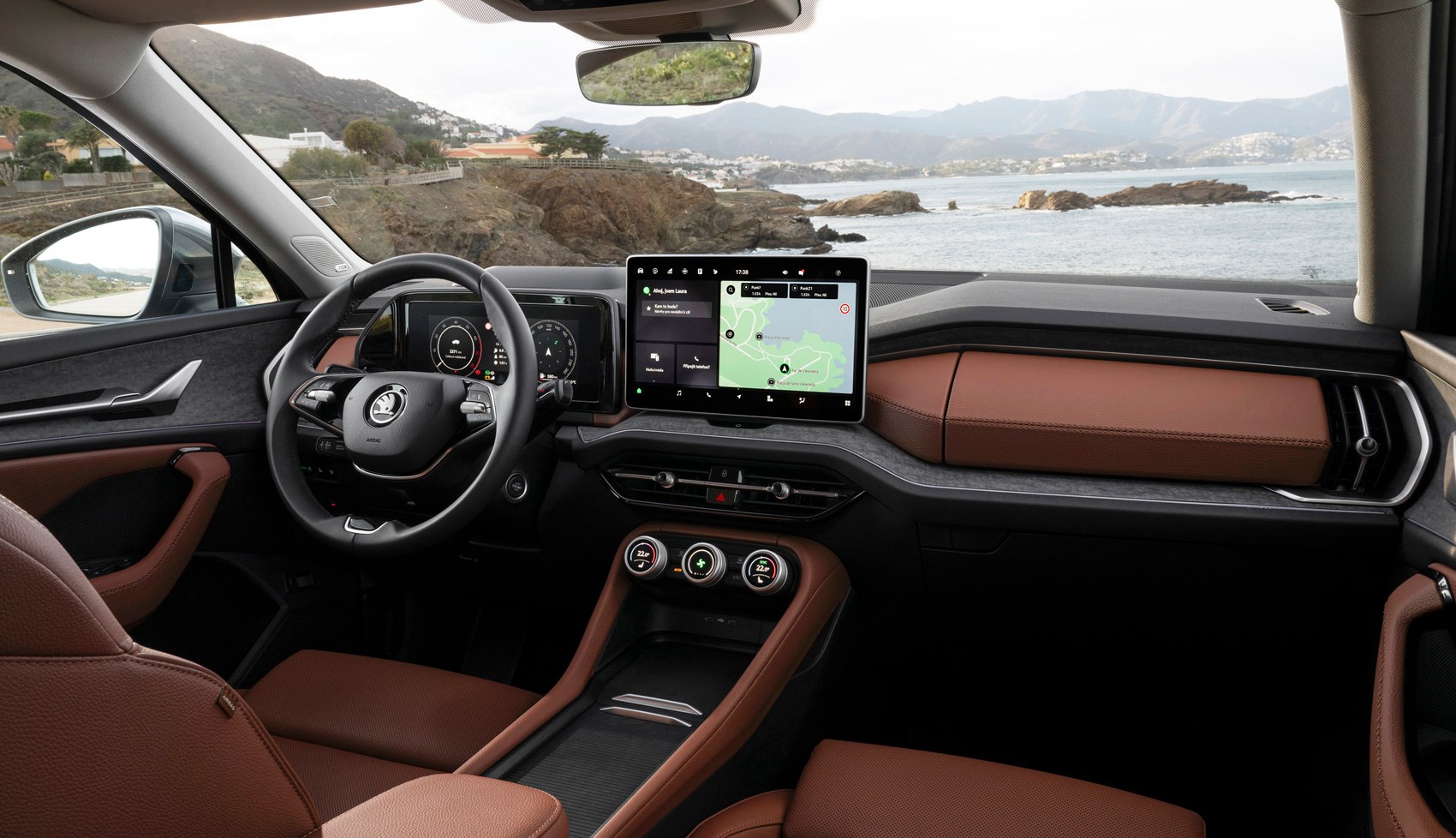
But visually it’s more of the same: not exactly handsome, and not a world apart from various Seat, VW and Audi products, but it succeeds in looking smart, modern, functional and stylish enough.
What are the specs?
Initially there are two spec levels, SE and SE L. Sportline will be along soon, with marginally more visual pizzazz. And later there will be a vRS version.
SE comes with 18-inch wheels, front and rear LED lights, heated front seats and three-zone climate control, plus a bunch of safety-enhancing electronics. SE L – priced from £40,205 – has 19-inch wheels as standard, adaptive matrix LED headlights, an electronically adjustable driver’s seat and electric boot opening. There are also various interior design packages available, called ‘selections’, following the pattern established by the Enyaq.
There are several engines to pick from: a 148bhp mild-hybrid 1.5-litre petrol four-cylinder, a 201bhp 2.0-litre TSI (which is all-wheel-drive only), a 148bhp 2.0-litre diesel four and a 190bhp version (the latter being only for all-wheel drive). Some models are available with DCC adaptive suspension, which when set in Sport mode adds a welcome firmness.
The PHEV is front-wheel drive and five seats only. It has a six-speed DSG automatic transmission, where the others all have seven speeds. But there’s no electric option. If you want a Skoda SUV with EV propulsion, you need to be looking at the Enyaq.
What about the interior?
The best thing about the Kodiaq. There’s nothing radically different or innovative, but it’s a very successful mix of familiar and new, of traditional and advanced.
It’s still very roomy – in fact slightly roomier than before, with an expanded boot and more headroom for those in the third row, while having a sleeker shape that has reduced aerodynamic drag.
If you go for seven seats you get less boot space than five-seaters, and if you go for the plug-in hybrid version you get less luggage capacity than those opting for versions that don’t have a big battery under the floor. But even the least capacious boot is still usefully roomy, and the largest is cavernous: 910 litres with the second row in use, and 2105 litres with them folded down, which is done with a simple flick of a lever.
The passenger seats split 60:40, and can be slid forwards or back to give more boot space or more legroom. Even with the front seats back and the back seats forwards, adults will be comfortable.
Rear passengers get heating controls and chargers plus a centre console of sorts, with oddments space and two cupholders. This can be removed if an adult is going to sit in the middle seat.
Up front the centre console is a masterclass in practicality. As the new Kodiaq is not available with a manual gearchange, the selector has been moved to the steering column, freeing up lots of space, which Skoda’s interior designers have used well. There are up to four cupholders, depending how you choose to arrange it, plus wireless charging areas for two phones, a couple of C-USB ports, and a lot of space in the armrest.
The dashboard now hosts a 13-inch central touchscreen, which is logically laid out and configurable. It can be largely ignored on the move, thanks to three physical multi-purpose dials below the screen, which between them control functions including driving modes (on those models that have modes), volume and heating. It’s an intuitive, effective arrangement.
The steering wheel isn’t overburdened with controls, but those that are present are easy to operate without taking your eyes off the road. The wheel itself may look as though it’s flat-bottomed, but that’s an illusion – it’s actually round, with a decorative protrusion around the 6 o’clock mark.
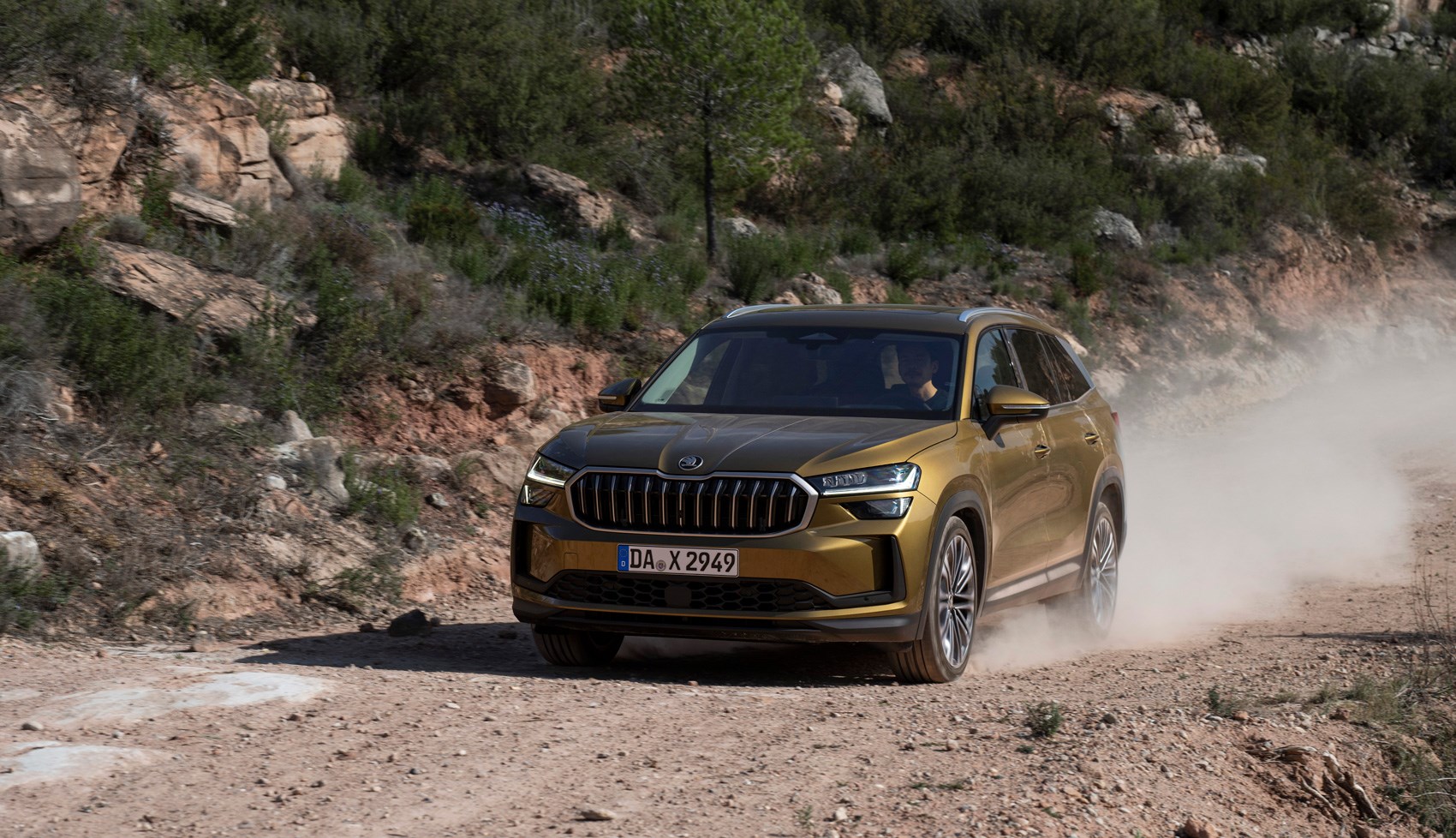
The doors have those useful removable rubbish bins for sweet wrappers and the like in their pockets, and slotted into the driver’s door itself is an umbrella – a familiar Skoda touch, along with the ice scraper clipped into the fuel filler cap. A new detail, along similarly user-friendly lines, is the cap on the screenwash reservoir under the bonnet. It opens up into a funnel that will reduce the amount of wasteful splashing.
Interior fabric choices include a really nice material that is made of recycled plastic, and leather that is treated with coffee-bean waste, rather than chemicals, in the tanning process.
A head-up display is now available, and there’s the option of a big glass sunroof to bring a bright ambience to the cavernous cabin. Despite its size, it doesn’t sound boomy or creaky, thanks to a combination of effective sound-deadening and sturdy construction.
How does it drive?
We’ve sampled four versions so far: two diesels, the mild hybrid and the plug-in hybrid. They weren’t in complete alignment with UK spec, but close enough for us to be pretty confident about their respective strengths and weaknesses.
The mild hybrid, which we drove on a demanding route involving many hairpin bends and some fast motorway miles, returned an impressive real-world 35mpg. But as you might expect from a 148bhp motor in such a big car, it doesn’t offer scorching performance. On those hills, it wasn’t exactly struggling but it certainly wasn’t shining. In more typical family driving, it’s smooth, lively enough and easygoing.
The plug-in hybrid is much perkier, reflected in a 0-62mph time that, at 8.4 seconds, is 1.3 seconds quicker. And if it replicates the official figures, it will top 60 miles of electric-only running, using its 25.7kWh battery, and recharge quickly. But a much longer drive will be needed to check that out.
Quite possibly the sweet spot in the range is the lesser of the two diesels. In five-seat SE guise, it costs £38,945 and combines a 9.6sec 0-62mph time with economy around 50mpg. Its torquey nature makes it feel faster than that, and it’s untroubled by hills or heavy loads. The more powerful diesel is faster off the line, with a 7.8sec sprint time, but it’s thirstier, has a higher CO2 output, and currently only comes as a seven-seat 4×4 in SE L trim, which pushes the price to £56,225.
All this talk of performance is pretty much beside the point. The Kodiaq is not designed to by dynamically outstanding, and is at its best when it’s used for its core tasks of family holidays, the school run, shopping and taking vast quantities of garden waste to the tip.
Ride quality is good, but the body gets wobbly if you hammer it hard through the bends. And the steering is always a little vague and remote. That may change when the vRS version arrives, but for now the Kodiaq is going to bring at least as much pleasure to the passengers as to the driver.
Verdict: Skoda Kodiaq
The Kodiaq shows Skoda doing typical Skoda stuff very well. The details are fantastic, the refinement is good, it drives well but not brilliantly, and it gives off a general feelgood vibe rather than any eruptions of excitement.
There are plenty of choices for buyers wanting family-friendly SUVs, and this remains among the best, certainly when you factor in the cost. Its pricing undercuts the seven-seat Hyundai Santa Fe. The Mercedes GLB, Peugeot 5008 and Land Rover Discovery Sport are classy seven-seat alternatives, but not as roomy.
And if you don’t want seven seats, you have a huge variety of alternatives. Don’t overlook Skoda’s own similarly priced Superb estate, which has the same clever design, technology and detailing as the Kodiaq, but a little more to engage the driver too.
That said, the Kodiaq is a very pleasing all-round package, with the prospect of better versions still to come.
Specs
Price when new: £36,645
On sale: Now
Engine: 1498cc mild-hybrid turbocharged four-cylinder, 148bhp @ 5000rpm, 184lb ft @ 1500rpm
Transmission: Seven-speed dual-clutch automatic, front-wheel drive
Performance: 9.7sec 0-62mph, 129mph, 42.8-47.8mpg, 135-151g/km CO2
Weight / material: 1586kg/steel
Dimensions (length/width/height in mm): 4758/1864/1659
Source: carmagazine.co.uk
Cheapest electric cars in 2024
Just a few years ago, the number of available affordable electric vehicles was significantly smaller. Listing the EVs under $50,000 for 2024, though, is a more laborious undertaking, as the list has grown despite the discontinuation of a couple models, requiring all your fingers and toes to count them. Some of these models haven’t hit the market as of this writing, but will be arriving some time this year.
Depending on how much you’re willing to spend dictates how much you’ll get in terms of acceleration, range, the number of wheels driven, vehicle size and feature content. While most of the EVs on this list have their own merits, you might still want to check out our list of the best EVs under $50,000. And if you want to continue to save money after your purchase, we can also tell you which EVs are the cheapest to own and operate in 2024.
But, to start, you’ll have to get one in your driveway. So, if you want to go electric on a budget, these are the cheapest electric cars you can buy in 2024.
Cheapest electric cars to buy in 2024
Nissan Leaf — $29,280
The Nissan Leaf S is the only car on this list starting under $30,000. The Leaf is also the older model on this list, and may be getting an update in the near future despite Nissan launching the also-affordable Ariya. The Leaf can only be had with front-wheel drive, while many others on this list are rear-drive or available with all-wheel drive. One thing to consider is that it uses the antiquated CHAdeMO charging standard, though a CCS adapter is now available to make it compatible with more charging stations. The small battery provides 150 miles on a charge, with a bigger battery option providing a more respectable 250 miles of range.
Mini Cooper SE — $31,895
The Mini Cooper SE looks very much like the gas-powered Cooper we know and love, but quieter and smoother to drive. The big drawback is its lackluster driving range of 114 miles. This makes it a fun urban runabout, but limits practicality if you only have one car or need to put adults — or even child car seats — in the back seat.
Hyundai Kona Electric — $34,050
The Hyundai Kona Electric is another fun, front-wheel-drive EV, but packs more space for people and cargo after its redesign for the 2024 model year. It’s offered with two drivelines, but neither can be had with AWD, simplifying the math a bit. The Electric SE has a 133-horsepower motor mated to a 48.6 kWh battery with 197 miles of range. The Electric SEL and Limited get a larger, 201-horsepower motor paired to a 64.8 kWh battery, which Hyundai says is good for 260 miles.
Fiat 500e — $34,095
The Fiat 500 returns to the U.S. in electric form in 2024, offering a tiny competitor to the Mini Cooper SE. As of this writing, we’ve only driven the essentially identical European version as we await the imminent North American launch. Only one version of the Fiat will be available at launch, the 500e RED, which is a special edition collaboration with the RED charity that raises money to combat AIDS. The new 500e will offer 149 miles on a charge, which is not great, but perhaps to be expected as one of the cheapest EVs you can buy. There’s also only so many batteries you can pack into such a small car.
Chevrolet Equinox EV — $34,995
Another EV that hasn’t launched as of this writing, the Chevy Equinox EV takes the place of the Chevy Bolt — at least for now — as the brand’s cheapest electric offering. The base 1LT comes equipped with a single-motor front-wheel drive powertrain that produces 210 horsepower and 242 pound-feet of torque. It’s paired with the smallest battery pack, and Chevy estimates a 250-mile range on a full charge, but you can get higher-spec Equinox EVs that still won’t break the bank.
Volvo EX30 — $36,245
Coming some time in 2024, the Volvo EX30 is surprisingly affordable for this luxury nameplate. And, as we wrote in our first drive, “Volvo’s new entry-level EV is inexpensive, not cheap.” The single-motor variant has a nice, simple interior, drives well and is chock full of features. Jumping up to the Twin Motor Performance version, though, adds almost $10,000 to the price.
Fisker Ocean — $38,999
The Fisker Ocean is a newcomer on the EV scene, and this small crossover starts at an affordable price. The front-wheel-drive Fisker Ocean Sport starts under $40,000, gets 231 miles of range, and does 0-60 in 6.9 seconds. Prices jump significantly from there as you move up the trim ladder, though. You should know, however, that the Ocean has had many reports of serious problems, leading to canceled reservations and a NHTSA investigation. Buyer beware.
Tesla Model 3 — $40,380
The popular Tesla Model 3 is one of our favorite electric sedans, and one of the top EVs under $50,000. The base model comes with rear-wheel drive and 272 miles of range. The Dual Motor AWD model still starts well under $50,000, with more power and 341 miles of driving range.
Kia Niro EV — $40,975
The Kia Niro is one of our favorite small SUVs, and the electric version adds fantastic efficiency to the well-rounded package. It doesn’t offer all-wheel drive, but it does provide 253 miles of range on a single charge. If it’s a little too much money for you, try the related Hyundai Kona Electric that offers a considerably cheaper, short range version.
Volkswagen ID.4 — $41,160
The VW ID.4 electric crossover starts just over $40,000 with rear-wheel drive. As of this writing, driving range hasn’t been announced for the 2024 model year, but we expect somewhere around 209 miles from the 62-kWh battery, based on the 2023 model. You can move up to a bigger battery, though, and all-wheel drive is available (although the price is much higher than typical because it also adds considerably higher performance). We like the driving dynamics and the roominess of the cabin, but interior controls and the infotainment system can be frustrating to use.
Mustang Mach-E — $41,695
An electric crossover worthy of the Mustang name, the Ford Mustang Mach-E is a thoroughly entertaining and attractive vehicle with a lot to love. The entry-level Select RWD trim offers 250 miles of range and a 0-60 time of 6.3 seconds. You can get all-wheel drive for $3,000 more, with a range of 226 miles. More power and range comes at a higher price.
Hyundai Ioniq 5 — $43,175
We’re huge fans of this funky, retrofuturistic hatchback-looking crossover EV from Hyundai. The cheapest SE Standard Range has rear-wheel drive and 220 miles of range, but you can get it with a bigger battery for 303 miles of range and keep it under $50,000. All-wheel drive will cost quite a bit more since it adds considerably more performance as well as improved traction. Regardless of powertrain, the Hyundai Ioniq 5 is a fun, roomy, feature-rich EV with excellent charging speeds.
Hyundai Ioniq 6 — $43,565
Using the same E-GMP platform as the Ioniq 5, the Hyundai Ioniq 6 is a sleek electric sedan with even more driving range. The base SE RWD gets 361 miles on a charge, and moving up to AWD still nets 316 miles of range at a great price. It’s also great to drive, providing sportier driving dynamics than the 5. We called the Ioniq 6 the “best alternative to a Model 3.”
Kia EV6 — $43,975
Yet another model based on Hyundai Group’s E-GMP electric vehicle platform, with its long range and fast charging speeds, the Kia EV6 has a sportier vibe than the lounge-like Hyundai Ioniq 5. The cheapest EV6 Light trim has rear-wheel drive, and a 58-kilowatt-hour battery pack good for 232 miles of range, though you can get more driven wheels, more range and more power for more money.
Toyota bZ4X — $44,420
Toyota’s first real EV, the bZ4X offers a good value in its front-wheel-drive versions, and is easier for most people to live with than its rear-drive competition. Just don’t expect something as fully realized as the exceptional Ioniq 5 and EV6, nor even the characterful but flawed ID.4. It has a 71.4-kilowatt-hour battery that returns an estimated 252 miles of range with the XLE trim and 242 with the Limited. All-wheel drive adds price, but diminishes driving range considerably.
Nissan Ariya — $44,555
The Nissan Ariya, the brand’s second electric vehicle, impresses with strong specs, compelling value and knock-out interior. The base Engage FWD provides 216 miles, though you can get all-wheel drive and more range if you’re willing to crest $50,000. Charging is on the slow side compared to much of the competition, though, particularly those from Hyundai and Kia.
Tesla Model Y — $46,380
The Tesla Model Y is a more traditional entry than the larger, more expensive Model X SUV. It’s more akin to the also-affordable and also-great Model 3 sedan, with normal doors and rear seats that fold to give you flexibility between passengers and cargo. It has a minimalist interior, with many of the vehicle functions accessed through the large infotainment screen, for better or worse. The base rear-wheel drive model gets a respectable 260 miles of range, but moving up to the Model Y Long Range, which offers 330 miles of driving and all-wheel drive, puts you just a few hundred dollars over the $50,000 mark. Still, the Model Y is a popular EV, and it, like the rest of the Tesla brand, has its fair share of fans. And let’s not forget that Tesla also has its excellent Supercharger fast-charging network. Furthermore, as of this writing, Tesla has cut prices on the vehicles in its inventory after producing so many of them, so there could be hotter deals on backlog units.
Subaru Solterra — $46,735
Subaru’s first EV, the Solterra electric crossover, is basically the same vehicle as the Toyota bZ4X with which it was co-developed. One key difference: even the base Premium trim comes with all-wheel drive — kind of a Subaru thing to offer as a standard feature — and 228 miles of range. It’s a great option for the Subaru faithful who have been waiting for an electric vehicle to get them more quietly to the great outdoors they love.
Vinfast VF 8 – $47,200
Vinfast is a Vietnamese automaker, and its cheapest VF 8 EV is only available in California as of this writing. We haven’t had the chance to review the VF 8 yet, so we can’t recommend it to you (reviews by other outlets have not been favorable, to say the least). The cheapest Eco trim offers an EPA-rated 207 miles of range.
Honda Prologue — $48,795
The Honda Prologue crossover is the Japanese automaker’s first mass-market EV for the U.S. market, but under the skin, it is built on GM’s Ultium electric vehicle platform, features an interior using GM parts and is even built in a GM factory in Mexico. Hitting dealers in March 2024, the base, single-motor EX trim provides an impressive 296 miles of range. The comparable Chevy Blazer EV won’t be available in such an affordable trim level for quite some time.
Source: autoblog.com
BMW iX2 review - Driving Experience, Design, Build and more...
Another BMW EV, this time a small, very trendy one, the iX2. Jonathan Crouch takes a look at what's on offer.
Ten Second Review
The market's first fully electric compact coupe crossover is this car, the iX2. It's basically an iX1 in drag of course, but there's a little more to the iX2 that that. It's sharper to drive and has a degree or two more of the personality missing from its EV showroom stablemate. So many small EVs today are disappointingly sterile in character. This one at least, is a little different.
Background
For most of the last decade, BMW's smallest full-electric offering was the innovative and charismatic little i3. For any who might have found its conventional-looking iX1 replacement in 2022 a touch on the dull side, the Munich maker has brought us this, the iX2.
As with the combustion-powered second generation X2, BMW's tried to do a little more here than simply provide a sleeker-looking version of the model that sired it, in this case the iX1. So we're promised sportier handling to go with the trendier Coupe-SUV visual vibe. The price here might be pushing up towards the kind of level that would get you a slightly larger lower mid-sized EV crossover. But the Bavarian brand hopes that this iX2's combination of looks, life and fashion might make you want one anyway.
Driving Experience
Initially, the iX2 is only being offered in top xDrive30 form, which has two electric motors, AWD and 313hp (62mph in 5.6s). Drive range is up to 266 miles, though to achieve that, you'd have to select the most frugal 'Efficient' MyMode drive setting and make full use of all the various provided energy recuperation settings. There are selectable high, medium or low braking energy recovery settings, or you can simply leave the system in its automatic adaptive setting. Do that and thanks to intelligent networking, the drive system can use navigation and driver assistance system data to adjust how much power is recuperated, according to the respective traffic situation.
As with the combustion X2, sharp Sport steering is standard, as is adaptive M Suspension with adjustable and frequency-selective dampers. The Bavarians have also included rear actuator wheel slip limitation to maximise agility, with a traction control system integrated into the engine management. This allows corrective inputs to be applied up to ten times faster than with conventional systems, benefiting traction, poise and handling stability. The suspension system's been designed with special axle kinematics and lift-related damping on the front axle. And there's a powerful integrated braking system with four-piston fixed-caliper front discs.
Design and Build
Visually, this iX2 isn't much differentiated from its combustion-powered X2 showroom stablemate. The front is dominated by an enormous pair of blanked-off kidney grilles which can be illuminated and are flanked by LED headlights that extend back into the flared front arches. In profile, the roof line slopes back dramatically, before being truncated by a blunt rear end. Striking? Certainly. Pretty? Not so much.
And inside? Well if you've tried the iX1, you'll know what to expect: a very avant garde cabin based around a curved glass fascia panel incorporating a 10.25-inch digital instrument display and a 10.7-inch central touchscreen. The iDrive software behind the set-up is BMW's 'Operating system 9' package, which gives you a new 'Quick Select' feature, allowing you to activate key functions without endless scrolling through sub-menus.
As with the ordinary X2, the rear bench is a little more spacious than you might expect and doesn't have that much less headroom than the iX1. Out back, there's a 525-litre boot, which is 10-litres more space than you'd get in an X2 sDrive20i and, interestingly, 35-litres more than you'd get in a supposedly boxier iX1. That extends to 1,400-litres with the rear seats down.
Market and Model
Pricing for this iX2 started from launch from just over £56,500 in xDrive30 AWD form. That's over £9,000 more than the combustion alternative, the X2 M35i xDrive. With the iX2, there's only one trim level - 'M Sport'. That's the one most customers would have chosen anyway because it provides the various visual cues this car needs to look in any way sporty. Specifically, this trim level includes large side air intakes integrated into the front apron, a body colour border along the lower edge of the body, M-specific side skirts, M High-gloss Shadowline exterior trim and a rear apron with integrated diffuser.
Adaptive M suspension and double-spoke 19-inch M light-alloy wheels are also part of the M Sport specification, together with sport seats, an Alcantara-covered instrument panel, an anthracite-coloured headliner and an M leather steering wheel with gearshift paddles. On the options list is the 'M Sport Pro' pack. Among the features this adds are M High-gloss Shadowline exterior trim with extended elements, M lights Shadowline exterior trim, an M rear spoiler, an M Sport braking system with red-painted callipers and M seat belts.
There's a comprehensive media package that includes 'Apple CarPlay' and 'Android Auto' wireless smartphone integration. And BMW ConnectedDrive upgrades keep the car up to date with the latest software, with upgrades ranging from new services to improved vehicle functions. Specify the 'Comfort Access' pack and you'll get the 'BMW Digital Key Plus' feature, which will allow you to lock or unlock your iX2 with your Apple iPhone. And you'll be able to share this functionality with up to five users using the 'My BMW app'.
Cost of Ownership
This iX2, as we told you in our 'Driving' section, can go up to 266 miles on a single charge. For that, you'll need to select the most frugal of the provided MyMode drive settings - 'Efficient'. And you'll also need to make full use of the brake recuperation energy you'll get while driving in the provided 'B' gear setting. Recuperation of up to 120kW can be generated via the brake pedal regardless of the driving mode. If you're rapidly running out of battery charge, you might want to engage the provided 'MAX RANGE' function, where drive power and top speed are carefully restricted and comfort functions scaled back, allowing range to be increased by up to 25%.
The iX2 can support single and three-phase AC charging up to 11kW, which allows the battery to be fully replenished from empty in 6.5 hours. As an option, you can increase charging capacity to 22kW, which allows the battery to be fully replenished from empty in just 3 hours 45 minutes. DC charging at up to 130kW makes it possible to boost the battery level from 10 to 80% in 29 minutes, or increase range by 75 miles in just 10 minutes.
Summary
We're starting to see small EVs that are more credibly sporting - and this iX2 is one of them. Obviously, like every full-battery crossover, it has to overcome a prodigious level of weight, but there's lots of advanced engineering here to mitigate against that. As a result, you might well find yourself having more fun at the wheel of this BMW than you might ever have expected to in a small EV.
Of course, you're going to need to like the way it looks: not everyone will. But the iX2 isn't intended to attract everyone, nor would it be as appealing if it was. Few people in your neighbourhood or company car park will have one. An EV you might want not just because it's an EV but because it's a BMW. In the truest sense.
Source: rac.co.uk
"It's time for Europe to respond to the threats posed by Chinese car brands"
"It's time for Europe to respond to the threats posed by Chinese car brands," said Renault Group CEO Luca de Meo, urging European Union countries to collaborate in addressing the imbalance in competition with China and the USA.
De Meo suggests that this approach would ensure the future of the automotive industry in Europe, similar to what was done in the case of the Airbus airline.
"We see increasing signs of weakness that could be cause for real concern if nothing is done," he stated in a public letter ahead of the European Parliament elections, as reported by Automotive News Europe.
De Meo, also the president of the European Automobile Manufacturers' Association (ACEA), published the letter in several languages as the leader of the Renault Group.
Among the proposals is for Europe to accelerate the pace of replacing older cars through a special fund over the next decade.
"The European automotive sector is under pressure from multiple fronts," he said, citing the transition to software-defined vehicles, increasing regulations, the need to invest in new technologies, price volatility of raw materials like lithium, and the need for workforce retraining to avoid mass unemployment.
"China rules, the USA stimulates, and Europe regulates," he wrote, emphasizing the longstanding issue of EU norms and regulations.
Among De Meo's proposals is support for the production of small, affordable cars, which he said could create 10,000 jobs.
"We see increasing signs of weakness that could be cause for real concern if nothing is done," De Meo wrote in the public letter, adding that "the center of gravity in the automotive industry has shifted to Asia, where about 52% of all cars sold in that region are produced, compared to 20% in Europe and 24% in North and South America."
As a consequence of Beijing's support for the electric car industry and the size of the Chinese domestic market, exports to Europe have increased fivefold since 2017, with the total trade deficit between Europe and China now standing at 400 billion euros.

